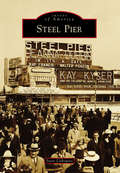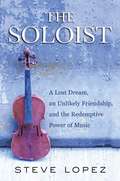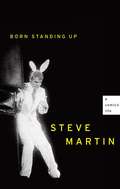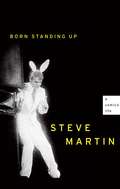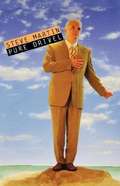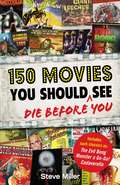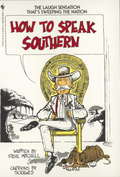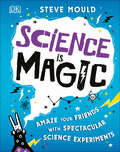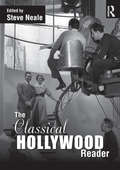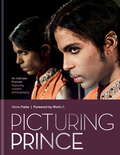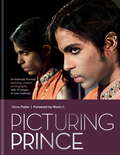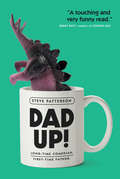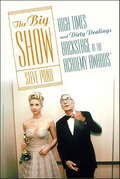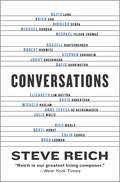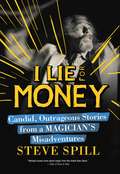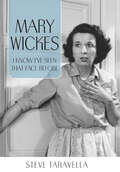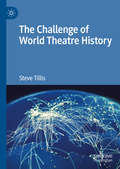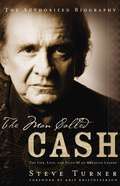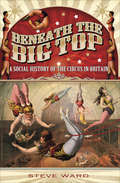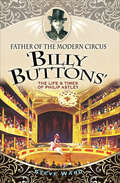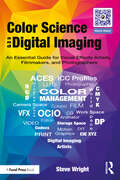- Table View
- List View
Steel Pier: Showplace Of The Nation (Images of America)
by Steve LiebowitzAtlantic City has worn the tag of "America's Playground" since its earliest days, so it is only natural that its biggest and most well-known icon, the Steel Pier, would be known as the "Showplace of the Nation." Over the course of 80 years, from 1898 to 1978, Steel Pier developed from a quiet, genteel amusement that featured light classical music and cakewalks to a vast entertainment complex that offered movies, big-name vaudeville acts, exhibits, big bands, rock bands, and the Water Circus with its famed diving horse. What makes this even more compelling is that one could spend the entire day on the pier and take all of this in for one small admission.
The Soloist: A Lost Dream, an Unlikely Friendship, and the Redemptive Power of Music
by Steve LopezWhen reporter Steve Lopez sees Nathaniel Ayers playing his heart out on a 2-string violin in LA's Skid Row, he finds it impossible to walk away. At first, he sees it as fodder for his column, but what Lopez begins to unearth about the mysterious street musician leaves an indelible impression. More than 30 years earlier, Ayers had been a promising classical bass student at Juilliard - ambitious, charming, and one of the few African-Americans at the school - until he gradually lost his ability to function, overcome by a mental breakdown. When Lopez finds him, Ayers is alone, suspicious of everyone, and deeply troubled, but glimmers of brilliance are still there.
Born Standing Up: A Comic's Life
by Steve MartinAutobiography by the 'wild and crazy guy' himself, how he was the biggest name in stand-up comedy in 1978, and how he walked away from it forever in 1981.
Born Standing Up: A Comic's Life (Thorndike Core Ser.)
by Steve MartinThe riveting, mega-bestselling, beloved and highly acclaimed memoir of a man, a vocation, and an era named one of the ten best nonfiction titles of the year by Time and Entertainment Weekly.In the mid-seventies, Steve Martin exploded onto the comedy scene. By 1978 he was the biggest concert draw in the history of stand-up. In 1981 he quit forever. This book is, in his own words, the story of “why I did stand-up and why I walked away.” Emmy and Grammy Award–winner, author of the acclaimed New York Times bestsellers Shopgirl and The Pleasure of My Company, and a regular contributor to The New Yorker, Martin has always been a writer. His memoir of his years in stand-up is candid, spectacularly amusing, and beautifully written. At age ten Martin started his career at Disneyland, selling guidebooks in the newly opened theme park. In the decade that followed, he worked in the Disney magic shop and the Bird Cage Theatre at Knott’s Berry Farm, performing his first magic/comedy act a dozen times a week. The story of these years, during which he practiced and honed his craft, is moving and revelatory. The dedication to excellence and innovation is formed at an astonishingly early age and never wavers or wanes. Martin illuminates the sacrifice, discipline, and originality that made him an icon and informs his work to this day. To be this good, to perform so frequently, was isolating and lonely. It took Martin decades to reconnect with his parents and sister, and he tells that story with great tenderness. Martin also paints a portrait of his times—the era of free love and protests against the war in Vietnam, the heady irreverence of The Smothers Brothers Comedy Hour in the late sixties, and the transformative new voice of Saturday Night Live in the seventies. Throughout the text, Martin has placed photographs, many never seen before. Born Standing Up is a superb testament to the sheer tenacity, focus, and daring of one of the greatest and most iconoclastic comedians of all time.
Pure Drivel
by Steve MartinFrom a wildly imaginative meditation on who Lolita would be at age 50 to a skit entitled "I Love Loosely," in which Lucy and Ricky Ricardo play the parts of Hillary and President Clinton, this collection by comic genius Martin is both hilariously funny and intelligent in its skewering of the topic at hand.
150 Movies You Should Die Before You See
by Steve MillerSure, everyone's seenThe Rocky Horror Picture Show,The Texas Chain Saw Massacre, andAttack of the Killer Tomatoes. But as you'll learn in this shockingly tasteless collection of great awful movies, there's so muchmoreto the world of truly bad film. You'll dive into the steaming swamp of such disastrously delicious movies as: Young Hannah, Queen of the Vampires Puppet Master versus Demonic Toys Creature with the Atom Brain Cannibal Holocaust Jesus Christ, Vampire Hunter For each movie, film buff and reviewer Steve Miller includes a list of principal cast, director, producer, a plot overview, why the movie sucked, a rating, choice quotes, interesting trivia, and a quiz. For anyone who's ever enjoyed awful movies, this is the book to have on the couch, along with the popcorn, as the opening credits flash on the screen forGingerdead Men 2: The Passion of the Crust.
150 Movies You Should Die Before You See
by Steve MillerSure, everyone's seen The Rocky Horror Picture Show, The Texas Chain Saw Massacre, and Attack of the Killer Tomatoes. But as you'll learn in this shockingly tasteless collection of great awful movies, there's so much more to the world of truly bad film. You'll dive into the steaming swamp of such disastrously delicious movies as:Young Hannah, Queen of the Vampires Puppet Master versus Demonic Toys Creature with the Atom BrainCannibal HolocaustJesus Christ, Vampire HunterFor each movie, film buff and reviewer Steve Miller includes a list of principal cast, director, producer, a plot overview, why the movie sucked, a rating, choice quotes, interesting trivia, and a quiz.For anyone who's ever enjoyed awful movies, this is the book to have on the couch, along with the popcorn, as the opening credits flash on the screen for Gingerdead Men 2: The Passion of the Crust.
150 Movies You Should Die Before You See
by Steve MillerSure, everyone's seen The Rocky Horror Picture Show, The Texas Chain Saw Massacre, and Attack of the Killer Tomatoes. But as you'll learn in this shockingly tasteless collection of great awful movies, there's so much more to the world of truly bad film. You'll dive into the steaming swamp of such disastrously delicious movies as:Young Hannah, Queen of the VampiresPuppet Master versus Demonic ToysCreature with the Atom BrainCannibal HolocaustJesus Christ, Vampire Hunter For each movie, film buff and reviewer Steve Miller includes a list of principal cast, director, producer, a plot overview, why the movie sucked, a rating, choice quotes, interesting trivia, and a quiz.For anyone who's ever enjoyed awful movies, this is the book to have on the couch, along with the popcorn, as the opening credits flash on the screen for Gingerdead Men 2: The Passion of the Crust.
How to Speak Southern
by Steve MitchellThe laugh sensation that swept the nation, How to Speak Southern and More How to Speak Southern, is now collected in one complete--and completely hilarious--volume. Embraced by Southerners everywhere and dedicated to all Yankees in the hope that it will teach them to talk right, this uproarious book decodes "Suthun" wit and wisdom for "Nawthun" upstarts everywhere. From "aig" (a breakfast food that may be fried, scrambled, boiled, or poached) to "zackly" (as in "precisely"), here's just a sampling of what you'll find inside: ATTAIR: Contraction used to indicate the specific item desired. "Pass me attair gravy, please." EVERWHICHAWAYS: To be scattered in all directions. "You should have been there when the train hit that chicken truck. Them chickens flew everwhichaways." YONTNY: Do you want any. "Yontny more corn bread?" Funny as well as informative, this laugh-out-loud dictionary will keep you laughing and learning--no matter where you fall on the Mason-Dixon Line!
Science is Magic: Amaze Your Friends With Spectacular Science Experiments
by Steve MouldPacked with over 40 magical science tricks for kids using simple experiments! Join comedian and author Steve Mould, #1 bestselling author of How to be a Scientist, and learn the secrets behind some of the most famous magic tricks and illusions (and learn some of your own). Learn how to bend water with a balloon, turn water into juice, make a glass beaker disappear in oil, and wow your friends with levitating tinsel! Packed with optical illusions, pranks, and fun facts, this ebook is a must-have for any aspiring scientist or magician (the two aren't as different as you might think)!Each trick is explained using step-by-step photographs, and the science behind each one is showcased clearly and simply. Sprinkled throughout the ebook are profiles of famous magicians and illusionists, such as Harry Houdini and David Blaine, and stories of how they used science to create their most famous tricks.Science is Magic is the perfect addition to any family bookshelf or classroom, putting a fresh spin on science for kids. What's fantastic about this kids&’ activity ebook is that many of the magic tricks or experiments are something you learn to perform on a friend and require practice. Thus, (the genius bit) it&’s not something kids will just do once and then turn the page.Think Magic Is Just An Illusion? Think again! Discover science - REAL magic at your fingertips. Learn some amazing experiments to wow your friends, find out how magicians use science in their most famous tricks, and discover the magic of the world around you. Packed with activities for kids from magic tricks to optical illusions, and peppered with fascinating facts, this educational ebook is a must-have for scientists and magicians alike. Added bonus, each &‘trick&’ or experiment in the ebook uses simple items that can be grabbed from home or a hardware store. Get ready to wow your friends with some cool science-backed magic like:- Magnetic fingers- Reading minds- Color changing potion- Guess the coin- Floating ping pong ball and much more! Add other fun-filled Steve Mould titles in the DK collection to your bookshelves, like How To Be A Scientist and The Bacteria Book.
The Classical Hollywood Reader
by Steve NealeThe Classical Hollywood Reader brings together essential readings to provide a history of Hollywood from the 1910s to the mid 1960s. Following on from a Prologue that discusses the aesthetic characteristics of Classical Hollywood films, Part 1 covers the period between the 1910s and the mid-to-late 1920s. It deals with the advent of feature-length films in the US and the growing national and international dominance of the companies responsible for their production, distribution and exhibition. In doing so, it also deals with film making practices, aspects of style, the changing roles played by women in an increasingly business-oriented environment, and the different audiences in the US for which Hollywood sought to cater. Part 2 covers the period between the coming of sound in the mid 1920s and the beginnings of the demise of the `studio system` in late 1940s. In doing so it deals with the impact of sound on films and film production in the US and Europe, the subsequent impact of the Depression and World War II on the industry and its audiences, the growth of unions, and the roles played by production managers and film stars at the height of the studio era. Part 3 deals with aspects of style, censorship, technology, and film production. It includes articles on the Production Code, music and sound, cinematography, and the often neglected topic of animation. Part 4 covers the period between 1946 and 1966. It deals with the demise of the studio system and the advent of independent production. In an era of demographic and social change, it looks at the growth of drive-in theatres, the impact of television, the advent of new technologies, the increasing importance of international markets, the Hollywood blacklist, the rise in art house imports and in overseas production, and the eventual demise of the Production Code. Designed especially for courses on Hollywood Cinema, the Reader includes a number of newly researched and written chapters and a series of introductions to each of its parts. It concludes with an epilogue, a list of resources for further research, and an extensive bibliography.
Picturing Prince: An Intimate Portrait
by Steve ParkePICTURING PRINCE sees the late icon's former art director, STEVE PARKE, revealing stunning intimate photographs of the singer from his time working at Paisley Park. At least half of the images in the book are exclusively published here for the first time; most other images in the book are rare to the public eye.Alongside these remarkable images are fifty engaging, poignant and often funny written vignettes by Parke, which reveal the very human man behind the reclusive superstar: from shooting hoops to renting out movie theatres at 4am; from midnight requests for camels to meaningful conversations that shed light on Prince as a man and artist. STEVE PARKE started working with Prince in 1988, after a mutual friend showed Prince some of Steve's photorealistic paintings. He designed everything from album covers and merchandise to sets for Prince's tours and videos. Somewhere in all of this, he became Paisley Park's official art director. He began photographing Prince at the request of the star himself, and continued to do so for the next several years. The images in this book are the arresting result of this collaboration.
Picturing Prince: An Intimate Portrait
by Steve ParkePICTURING PRINCE sees the late icon's former art director, STEVE PARKE, revealing stunning intimate photographs of the singer from his time working at Paisley Park. At least half of the images in the book are exclusively published here for the first time; most other images in the book are rare to the public eye.Alongside these remarkable images are fifty engaging, poignant and often funny written vignettes by Parke, which reveal the very human man behind the reclusive superstar: from shooting hoops to renting out movie theatres at 4am; from midnight requests for camels to meaningful conversations that shed light on Prince as a man and artist. STEVE PARKE started working with Prince in 1988, after a mutual friend showed Prince some of Steve's photorealistic paintings. He designed everything from album covers and merchandise to sets for Prince's tours and videos. Somewhere in all of this, he became Paisley Park's official art director. He began photographing Prince at the request of the star himself, and continued to do so for the next several years. The images in this book are the arresting result of this collaboration.
Picturing Prince: An Intimate Portrait
by Steve ParkePICTURING PRINCE sees the late icon's former art director, STEVE PARKE, revealing stunning intimate photographs of the singer from his time working at Paisley Park. At least half of the images in the book are exclusively published here for the first time; most other images in the book are rare to the public eye.Alongside these remarkable images are fifty engaging, poignant and often funny written vignettes by Parke, which reveal the very human man behind the reclusive superstar: from shooting hoops to renting out movie theatres at 4am; from midnight requests for camels to meaningful conversations that shed light on Prince as a man and artist. STEVE PARKE started working with Prince in 1988, after a mutual friend showed Prince some of Steve's photorealistic paintings. He designed everything from album covers and merchandise to sets for Prince's tours and videos. Somewhere in all of this, he became Paisley Park's official art director. He began photographing Prince at the request of the star himself, and continued to do so for the next several years. The images in this book are the arresting result of this collaboration.
Picturing Prince: An Intimate Portrait
by Steve ParkePICTURING PRINCE sees the late icon's former art director, STEVE PARKE, revealing stunning intimate photographs of the singer from his time working at Paisley Park. At least half of the images in the book are exclusively published here for the first time; most other images in the book are rare to the public eye.Alongside these remarkable images are fifty engaging, poignant and often funny written vignettes by Parke, which reveal the very human man behind the reclusive superstar: from shooting hoops to renting out movie theatres at 4am; from midnight requests for camels to meaningful conversations that shed light on Prince as a man and artist. STEVE PARKE started working with Prince in 1988, after a mutual friend showed Prince some of Steve's photorealistic paintings. He designed everything from album covers and merchandise to sets for Prince's tours and videos. Somewhere in all of this, he became Paisley Park's official art director. He began photographing Prince at the request of the star himself, and continued to do so for the next several years. The images in this book are the arresting result of this collaboration.
Dad Up!: Long-Time Comedian. First-Time Father.
by Steve PattersonFrom one of the country's most beloved comedians and host of CBC Radio's incredibly popular program The Debaters comes a funny, poignant, and at times unexpectedly wise look at what it means to be a dad in this day and age.Steve Patterson has been thinking about dad-dom for quite a while. In Dad Up! he gives his all to be the best father possible to two young girls while imparting his hard-won wisdom and insights to readers everywhere.The youngest of five boys growing up in an Irish Catholic household, Patterson mines his childhood for any sage advice he might have picked up from his own dad. He talks with candour about the difficulty he and his wife, Nancy, had conceiving, finding humour in their experiences with the fertility clinic's automated phone calls (which Patterson calls "RoboPimp") informing them when Nancy was ovulating. He chronicles the disappointment of failing to get pregnant, only to have the miracle conception take place in Regina during Grey Cup Week, under the guiding spirit of the Saskatchewan Roughriders and comedian Brent Butt (don't ask).From that point on, Steve Patterson assumes full dad-mode, riffing on the biohazard that is changing a diaper, the absolute futility of stuffed animals, becoming a public breastfeeding warrior in the most unexpected of places, and how growing up a little boy in no way prepares you to being a father to little girls.Most importantly, Dad Up! charts the awesome experience of watching tiny infants that you somehow had a hand in creating evolve into confident and crafty little people, and the lessons that they teach along the way.
The Big Show: High Times and Dirty Dealings Backstage at the Academy Awards
by Steve PondAn unprecedented look at the machinations behind everyone's favorite Hollywood circus and what it reveals about the business of moviemaking.Oscar parties. Oscar pools. Oscar style. Oscar predictions. The Oscars breed their own peculiar mania and a billion people worldwide are alleged to watch the broadcast every year. While that figure may be the Academy's big white lie, the Oscars draw a viewership well into the hundreds of millions--a tremendous audience for what is essentially a television program. But this is no ordinary show. Love it or loathe it, the Oscars are an irresistible spectacle: a gloriously gaudy, glitzy, momentous, and foolish window into the unholy alliance of art and commerce that is the film industry. The Oscar statuette is a totem of such potency that millions are spent and careers laid on the line in the reckless pursuit of an eight-pound chunk of gold-plated britannium. The Big Show is a chronicle of the past fifteen years of the Academy Awards, the most tumultuous decade in Oscar's seventy-six year history. Written by the only journalist ever given carte blanche access to the planning, production, and backstage intrigue of the Oscars, it offers an unguarded, behind-the-scenes glimpse of this singular event, along with remarkable insight into how the Oscars reflect the high-stakes politics of Hollywood, our obsession with celebrities (not to mention celebrities' obsession with themselves), and the cinematic state of the union.
Conversations
by Steve ReichA surprising, enlightening series of conversations that shed new light on the music and career of &“our greatest living composer&” (New York Times)Steve Reich is a living legend in the world of contemporary classical music. As a leader of the minimalist movement in the 1960s, his works have become central to the musical landscape worldwide, influencing generations of younger musicians, choreographers and visual artists. He has explored non-Western music and American vernacular music from jazz to rock, as well as groundbreaking music and video pieces. He toured the world with his own ensemble and his compositions are performed internationally by major orchestras and ensembles.Now Reich speaks with collaborators, fellow composers and musicians as well as visual artists influenced by his work to reflect on his prolific career as a composer as well as the music that inspired him and that has been inspired by him, including:David LangBrian EnoRichard SerraMichael GordonMichael Tilson ThomasRussell HartenbergerRobert HurwitzStephen SondheimJonny GreenwoodDavid HarringtonElizabeth Lim-DuttonDavid RobertsonMicaela HaslamAnne Teresa de KeersmaekerJulia WolfeNico MuhlyBeryl KorotColin CurrieBrad LubmanThrough this series of insightful, wide-ranging conversations starting from his student days to the present pandemic, we gain a compelling glimpse into the mind of &“the most original musical thinker of our time&” (The New Yorker).
I Lie for Money: Candid, Outrageous Stories from a Magician’s Misadventures
by Steve SpillIn this funny, irreverent, unique, eccentric memoir, magician Steve Spill reveals how he managed to survive decades inside a rarely profitable, sometimes maddening, but often deliciously rewarding offbeat showbiz profession--magic! Spill tells of how his tailor grandfather sewed secret pockets in a magician’s tuxedo back in 1910, which started his childhood dream to become a magician. This dream took Spill on a journey that started with him performing, as a young boy, at a "Beauty on a Budget” neighborhood house party to engagements in Europe, Africa, and the Caribbean, to today in Santa Monica, California, where he’s been starring in his own shows since 1998 at Magicopolis, the theater he designed and built himself. Being a magician has given Spill the opportunity to interact with the world’s most famous and fascinating people. In his memoir, Spill reveals the many unique encounters that his profession has led him to enjoy and endure: hosting Sting as his opening act one night, spending two days on camera with Joan Rivers, and selling tricks to Bob Dylan, as well as encounters with Adam Sandler, Stephen King, and other celebrities. I Lie for Moneyis a literary magic show that captures the highs and lows of an extraordinary life that will delight and amaze you with wit and wickedness. This book should be an obligatory read for anyone considering a creative career, and it serves as an inspiration to those who desire to craft an independent life.
Mary Wickes: I Know I've Seen That Face Before (Hollywood Legends Series)
by Steve TaravellaMoviegoers know her as the housekeeper in White Christmas, the nurse in Now, Voyager, and the crotchety choir director in Sister Act. This book, filled with never-published behind-the-scenes stories from Broadway and Hollywood, chronicles the life of a complicated woman who brought an assortment of unforgettable nurses, nuns, and housekeepers to life on screen and stage. Wickes (1910–1995) was part of some of the most significant moments in film, television, theatre, and radio history. On that frightening night in 1938 when Orson Welles recorded his earth-shattering “War of the Worlds” radio broadcast, Wickes was waiting on another soundstage for him for a rehearsal of Danton's Death, oblivious to the havoc taking place outside. When silent film star Gloria Swanson decided to host a live talk show on this new thing called television, Wickes was one of her first guests. When Lucille Ball made one of her first TV appearances, Wickes appeared with her—and became Lucy's closest friend for more than thirty years. Wickes was the original Mary Poppins, long before an umbrella carried Julie Andrews across the rooftops of London. And when Disney began creating 101 Dalmatians, Wickes was asked to pose for animators trying to capture the evil of Cruella De Vil. The pinched-face actress who cracked wise by day became a confidante to some of the day's biggest stars by night, including Bette Davis and Doris Day. Bolstered by interviews with almost three hundred people, and by private correspondence from Ball, Davis, Day, and others, Mary Wickes: I Know I've Seen That Face Before includes scores of never-before-shared anecdotes about Hollywood and Broadway. In the process, it introduces readers to a complex woman who sustained a remarkable career for sixty years.
The Challenge of World Theatre History
by Steve TillisThe future of theatre history studies requires consideration of theatre as a global phenomenon. The Challenge of World Theatre History offers the first full-scale argument for abandoning an obsolete and parochial Eurocentric approach to theatre history in favor of a more global perspective. This book exposes the fallacies that reinforce the conventional approach and defends the global perspective against possible objections. It moves beyond the conventional nation-based geography of theatre in favor of a regional geography and develops a new way to demarcate the periods of theatre history. Finally, the book outlines a history that recognizes the often-connected developments in theatre across Eurasia and around the world. It makes the case that world theatre history is necessary not only for itself, but for the powerful comparative and contextual insights it offers to all theatre scholars and students, whatever their special areas of interest.
The Man Called CASH: The Life, Love and Faith of an American Legend
by Steve TurnerJohnny Cash is one of the most influential figures in music and American popular culture today. While he was an icon to people of all ages during his life, Cash's legacy continues after his death. His remarkable story is captured in this exclusive authorized biography, addressing the whole life of Johnny Cash-not just his unforgettable music but also his relationship with June Carter Cash and his faith in Christ. His authenticity, love for God and family, and unassuming persona are what Steve Turner captures with passion and focus in this inspiring book. Different from other books written about him, The Man Called CASH brings Cash's faith and love for God into the foreground and tells the story of a man redeemed, without watering-down or sugar-coating. Unquestionably one of the biggest book releases of 2004, The Man Called CASH will be a huge success with his millions of fans and will draw in many new fans with this inspiring story of faith and redemption.The audio book, ISBN 084996377X, is narrated by Cash's close friend and musical partner, Kris Kristofferson.
Beneath the Big Top: A Social History of the Circus in Britain
by Steve Ward&“A valuable and illuminating read, shedding a lot of light on the political, economic and technological factors that have driven circus evolution&” (The Circus Diaries). Beneath the Big Top is a social history of the circus, from its ancient roots to the rise of the &“modern&” tented travelling shows. A performer and founder of a circus group, Steve Ward draws on eyewitness accounts and contemporary interviews to explore the triumphs and disasters of the circus world. He reveals the stories beneath the big top during the golden age of the circus and the lives of circus folk, which were equally colorful outside the ring: • Pablo Fanque, Britain&’s first black circus proprietor • The Chipperfield dynasty, who started out in 1684 on the frozen Thames • Katie Sandwina, world&’s strongest woman and part-time crime-fighter • The Sylvain brothers, who fell in love with the same woman in the ring &“As a former circus performer and now teacher and circus professional I thoroughly enjoyed this book!! The Circus has such a rich history and Steve does an amazing job at not only chronicling it but also telling entertaining and wonderful stories throughout. The photos are also amazing!! I recommend this book for both circus professionals and also for everyone else . . . it is a fabulous read for all!!&” —Carrie Heller, Circus Arts Institute (Atlanta, GA)
Father of the Modern Circus 'Billy Buttons': The Life & Times of Philip Astley
by Steve WardThe world of the circus has a long and colorful history but it was with a man named Philip Astley that the modern circus was founded. It was 250 years ago, in April 1768, that Astley pegged out a circular ride on the banks of the river Thames and gave performances of trick riding to a paying audience. Trick riding was nothing new, so what made Astley so popular? He was an accomplished horseman, a military hero and an instinctive showman. Above all, he was an entrepreneur who realized that people would pay good money to be entertained and to be entertained well. He created the comic character of Billy Buttons, and other acts were added to his performances: clowns, rope dancers, tumblers and strongmen. The circus, as we might recognize it today, was born.Father of the Modern Circus Billy Buttons investigates the life and times of this veritable giant of the circus world. Standing well over 6 feet tall, with a stentorian voice and character to match, it was difficult to ignore him wherever he went. From his early days as an apprentice cabinetmaker and his military exploits in the 15th Dragoons to the trials and tribulations of establishing himself as a respected performer and his international successes in France and Ireland, this book gives a detailed account of the larger than life figure that was Philip Astley.
Color Science and Digital Imaging: An Essential Guide for Visual Effects Artists, Filmmakers and Photographers
by Steve WrightThis book, written by a leading expert in the field of visual effects (VFX), demystifies the complex subject of color science and how it should be managed from project ideation to completion. Readers will learn not only how things work, their capabilities and limitations, but also the color science that goes along with them, in an accessible and informative manner. Starting in the real world, with an understanding of light and our human perception of it, the book then explores how digital cameras "see" and digitize the scene. From the capture of these images, the author then explores the fundamental concerns of storage, editing, and managing color images, including with OpenColorIO and ACES, the Academy Color Encoding System. Written for professional photographers, cinematographers, VFX, motion graphics and computer graphics artists, editors, and colorists, this book will provide you with knowledge of the upstream and downstream technology of your job that will not only give you a competitive advantage and help you to make better images, but also give you a real-world working knowledge of color science.
